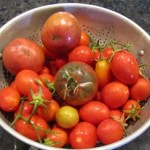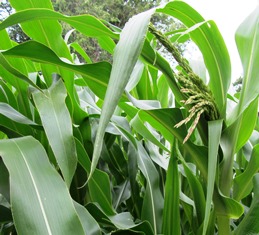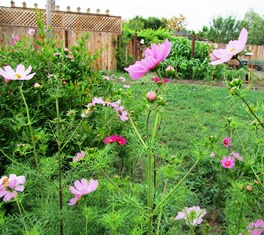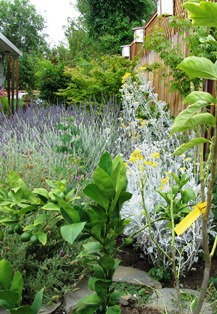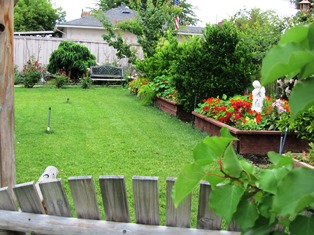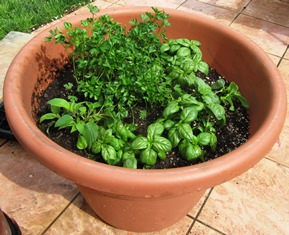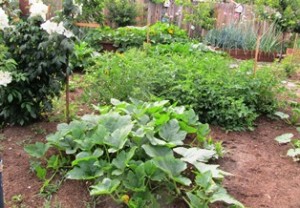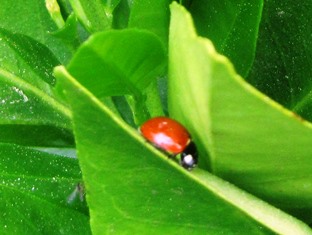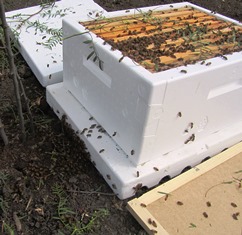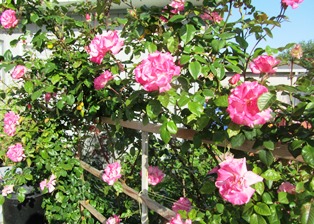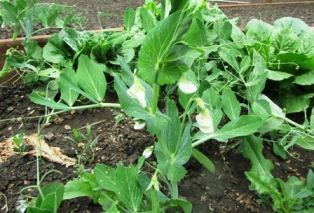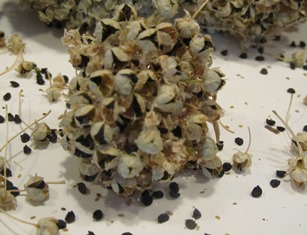Saving Tomato Seeds
In my Henny Penny Farmette garden this year, I grew different varieties of heirloom tomatoes: German Queen, Mortgage Lifter, Paul Robson (a Russian heirloom), Mt. Vesuvius, San Marzano, and others.
It’s the end of the season and my work now is to save seed and compost other plants that are no longer producing. Over the next couple of months, I’ll turn the soil and add amendments.
Since my tomato plants are open-pollinated, heirloom types (as opposed to patented hybrids), I can have a reasonable expectation of how the seeds will perform once planted in a future garden.
A word of warning about using patented hybrid seeds–growing plants from hybrid seed will not come true in your next year’s garden. They will likely be inferior plants compared to their parents.
However, open-pollinated seeds produce tomato plants that remain true to the parent plants (of course, some slight variation in nature is possible). But you can know with certainty that those seeds will remain true just as they have through generations of gardens.
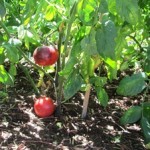
These are heirloom blue tomatoes. Avoid planting tomatoes in the same garden location year after year because of tomato blight and black rot. Let the soil recover for three years–tomatoes are heavy feeders.
When choosing which tomatoes to save seed from, keep two criteria in mind:
1) Choose tomatoes from vigorous plants, free of disease.
2) Select seed from tomatoes with characteristics (like the taste, skin thickness, size, and abundance) that you prefer.
I utilize a simple three-step method for saving my tomato seeds. I always select a prime tomato specimen that has reached its peak to be used for harvesting seed.
1. Use a sheet of paper towel for each type of tomato seed you are saving. Write on one corner of the paper towel the type of tomato seed and the year grown and whether determinate (often called bush) or indeterminate (vine which will keep growing until killed by frost). Most heirloom tomatoes are indeterminate.
2. Cut open the tomato and then scrape out seeds and spread them out across a paper towel. I put these towels on my kitchen counter or in a window to dry for 10-14 days.
3. Fold the paper towel and slip it into a paper envelope to use for your next year’s garden. I use one envelope per paper towel to ensure air circulation for good drying.
Come spring, these seeds can be planted into cell packs to become seedlings. Or, you can plant them directly into the garden after all danger of frost has passed.
___________________________________________________________________
If you enjoy reading about garden topics and like mysteries, check out my Henny Penny Farmette series of cozy mysteries, including A BEELINE TO MURDER, THE MURDER OF A QUEEN BEE, and A HIVE OF HOMICIDES (Kensington Publishing, NY).
I’ve also written dozens of health and wellness and spirituality books, all available online and everywhere books are sold.

More than 150 rituals for sound mind, strong body, and meaningful connections to the people around you
Edible Landscape: Our Garden of Gentle Disorder
I’ve long been enamored of the traditional French jardin potager or ornamental, vegetable kitchen garden. The kitchen garden has its roots the medieval jardin de curé, described by garden author Jean-Paul Collaert in Kitchen Gardens of France, by Louisa James (Thames and Hudson 1999), as a “garden of lines . . . not dabs of color” as opposed to the English cottage garden and the traditional vicarage garden.
Most potagers grow the traditional four types of plants: vegetables, fruit, flowers, and herbs. What I love is the revival of interest worldwide in heirloom fruits and vegetables, which are perfectly suited for a kitchen garden. On my farmette, I grow plants almost exclusively from heirloom seed.
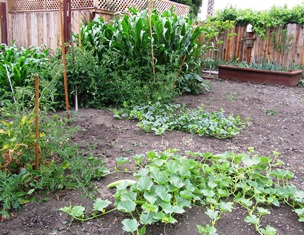
Corn, cucumber, and tomatoes share ground space; onions, garden peas, and eggplants thrive in boxes, table grapes spill over the fence
The medieval jardin de curé has been characterized by scholars as having plants in distinct beds laid out along formal lines (the Latin cross was popular). Gardening plots were defined by ge0metric shapes that could be quite complex (for example, the historic knot garden). Plants included herbs and flowers (many for medicinal uses), vegetables, berries, fruit trees, and ornamental trees and shrubs. This type of garden could be rustic or highly formal and could be found throughout France, from small farms and cloisters to country estates.
Our farmette garden has characteristics of the jardin potager and also the jardin de curé, although it could not be described as a true representation of either.
When we first moved to the farmette, we created and followed a master plan. The acreage follows a large rectangular-shape perimeter with our small house situated in the middle. Behind the house, a lawn is lined with gravel pathways. The pathways are dotted with boxes of herbs and flowers, mint, and berries. Between the boxes, the apricot, cherry, apple, fig, and persimmon trees are flourishing and producing bountiful crops.
In chaotic disorder, the beds of French perfume lavender and Spanish lavender that we planted have taken over one side of the property (much to the delight our honeybees), effectively erasing any lines that might have been obvious in an early layout. Interspersed with the lavender beds are iris, hydrangea, roses, lemon trees. Where the lavender turns a corner, bamboo creates a privacy screen, and then the fruit and flower-lined gravel path continues to the chicken house.
We moved dirt from the back half of the property and built a retaining wall along an L-shaped gravel path leading to a vegetable garden. Both sides of the path are lined with trees–apricot, pear, and pomegranate. On one side under a massive elm is a bed containing white geraniums and a variety of rose bushes.
We are following a plan for our own vision of a potager and, although I wish it had more of the lines of the medieval jardin de curé, our garden has the appearance of gentle disorder while being a prolific producer, in short, an edible landscape.
I love this living tableau. The appearance of the garden and grounds changes with the cycles of the seasons. Also ever-changing are the types of wildlife and songbirds frequenting the fountains and foraging on the fruits. There’s always something new to discover.
__________________________________________________________________
If you enjoy reading about farmette topics, gardening, and keeping chickens and honeybees, check out my series of cozy mysteries from Kensington Publishing in New York. Click on the link.
A HIVE OF HOMICIDES
Finding Treasures in the Seed Catalogs
As a member of the grow-your-own-food movement, I pore over seed catalogs this time of year to search for heirloom vegetables that I want to grow on my farmette. If you’ve ever been inspired by the heirlooms (and not just tomatoes) displayed at a farmer’s market, you know what I mean.
Some wonderful heirlooms have fallen out of favor over the years and through generations. That’s a shame for those of us interested in maintaining the widest possible plant diversity. Gardeners often can find lots of heirloom tomatoes such as Cherokee Purple, Brandywine, Mortgage Lifter, and the “blue” tomatoes, including Indigo Apple. However, finding a great variety of heirloom vegetable seedlings might not be as easy as locating the tomatoes. That’s where rare seeds come in to play.
Seed companies that offer myriad heirloom varieties of vegetables and herbs send out their catalogs around mid-January each year. But their seed offerings can be perused and purchased online as well. Some of my favorite seed companies and their websites include:
Territorial Seed Company, http://www.territorialseed.com/
Baker Creek Heirloom Seeds, http://www.rareseeds.com/
Heirloom Seeds, http://heirloomseeds.com
Sustainable Seed Company, http://sustainableseedco.com/
Annie’s Heirloom Seeds, http://www.anniesheirloomseeds.com/
High Mowing Organic Seeds, http://www.highmowingseeds.com/
Eden Brothers Seed,nhttp://www.edenbrothers.com/store/heirloom_seeds.htm
Victory Seeds,http://www.victoryseeds.com/main_vegies.html
I’ve already removed empty cell packs, potting soil, and ice cream sticks(for plant labels) and placed them on the patio in preparation for starting my own seedlings from seed.
Once the seeds are planted in the cells, I’ll nurture along the seedlings until they are ready to go in the garden (after all chance of frost has passed). Then, Mother Nature will take over. I’ll enjoy sampling new varieties and saving seeds from those I want to grow again.
Twelve Reasons to Grow Your Own Food
Doctors tell us we should eat fruits and vegetables for our health. Fresh is best. For more reasons to grow your own food, read on.
1. Enjoy Superior Flavor and Higher Nutritional Value
The flavor of produce that travels from your edible garden to your plate is far superior to that of store-bought varieties. Even before fresh produce reaches the bins of your local store, the fruits and vegetables must be picked, sorted, crated, and transported from suppliers t0 supermarkets and grocery stores. Time spent in transporting and storage can diminish food flavors and nutrient values.
2. Keep It Pesticide-Free
Go organic. Choose alternative methods (companion planting and organic sprays, for example) to treat garden pests and plant diseases. Organic farming starts with nourishing the soil, which in turn, nourishes the plants that nourishes a healthy body. Organically grown fruits and vegetables picked fresh, immediately prepared, and served are nutritionally superior than their commercially grown and stored counterparts.
3. Safeguard Your Health
Avoid the cancer-causing agents and toxic chemicals in pesticides that are commonly used on many commercially grown food products.
4. Cultivate Plant Diversity; Preserve History
Grow varieties of the vegetables and fruits you love. Or, choose cultivars that might have grown in your grandmother’s garden–a nod to preserving history. Or, plant varieties that have fallen out of favor, are unusual, or are even rare.
5. Lower Your Food Bill
Grow your own edibles and preserve them for later consumption (like freezing spring peas for a fall or winter meal). Preserving the bounty by drying or freezing or canning can reduce your grocery bills. Another cost and time saver is to grow hard-to-find varieties of heirloom herbs, vegetables, or fruits instead of tracking down sources for those items.
6. Expand Your Knowledge of Plants
Understanding the seed-to-harvest cycle in nature fosters deep appreciation for ecology and the environment and contributes to your knowledge about various plants’ needs for nutrients, water, light, and temperature. You also learn about treatment options for garden-variety pests and plant diseases. This wealth of information can be shared with younger generations who will inherit the responsibility of caring for the planet.
7. Get Exercise
You can still work out, albeit in the garden in the fresh air rather than in an indoors gym. Think about all the exercise you’ll get digging, planting, shoveling, watering, weeding, and composting. Gardening provides plenty of solid exercise and rejuvenates a weary spirit.
8. Reduce Your Stress
Time spent in a garden is restorative: it nourishes your spirit and reduces stress levels. In fact, just a few moments of deep breathing and thinking about birdsong, sunshine, fresh air, and healthy plants all around you–nature in all its splendor–can generate a positive mental attitude.
9. Alleviate Concerns about Food Safety and Quality
You know the quality of the food you bring from your edible garden to the table. You want the superior freshness, flavor, and food quality for your loved ones. The chances for food-borne illnesses of the kind that strike Americans every year and are often investigated by the Centers for Disease Control (CDC) are vastly diminished when you grow organic edibles and eat them as fresh as possible.
10. Preserve Our Planet’s Diversity
Choose seeds that are open-pollinated, non-GMO (genetically modified organism; the result of scientists engineering or modifying the genetic material of food plants). It may come as no surprise that the health of our nation has declined with the demise of small family farms even as there’s been a rise in the number of supermarkets and expansion of modern agribusiness. It’s no wonder people everywhere are getting behind buy-local, keep-it-local movements; participating in farmers’ markets, and engaging in urban homesteading where self-reliance is paramount.
11. Earn Extra Money
Selling your home-grown produce to others in your community means you can make possible the goodness of organic produce to others while earning a little money (hint: buy more seeds or otherwise reinvest in your garden).
12. Feel Good about Donating Excess Produce to a Food Bank
Your local food bank or (sometimes churches, too) will distribute donated produce to needy families. Let it be a source of joy for you that your gardening efforts have literally put food in the mouths of those in less fortune life circumstances.
Have You Planned Your Garden Yet?
Ladybugs and honeybees occasionally meet on the same leaf when both forage for food. The ladybugs dine on aphids while the honeybees seek the sweet nectar of blossoms; orange, tangerine, and lime trees are favorites.
The bug and bee traffic has been steadily increasing now that showers and warm weather have triggered blossoms opening on the fruit and citrus trees around the farmette.
Spring doesn’t officially begin until March 20, but with the weather forecasters predicting upper 70’s Fahrenheit later this week and nighttime temperatures in the 50’s, it is time to consider options for your garden. Many DIY centers are already offering vegetable seedlings, herbs, and berries for planting. Some have markedly discounted their bare-root fruit trees and roses.
I’ve already planted seeds in flats for germination and scattered flower seed (collected from last summer’s flower garden) around prepared beds. When the outside temperatures start to climb, I’ll be rewarded with blooms from nasturtiums, petunias, zinnias, and sunflowers.
The climbing roses are already past the red-leaf stage and are producing the first flush of blooms for spring. The wisteria vines have plump pods ready to unfurl with gorgeous tracts of purple blossoms. And the first green tips of leaves are beginning to sprout on my apples even as the early peaches and apricots already have fruit forming.
This time of year holds the promise of new beginnings, and you see that in every step you take in a garden. Because I prefer to grow plants from varieties of heirloom, open-pollinated seed, I save it from the best specimens grown in the previous season. Of course, some plants freely re-seed themselves. That’s why I now find lettuce and onions and even sweet peas coming up in expected places on the property.
Have you figured out what veggies, flowers, fruits, and berries you’ll plant and grow in your garden this year? If not, now’s a good time to get started. For ideas, check out, http://www.organicgardening.com/learn-and-grow/plan-beautiful-vegetable-garden.
If you prefer, as I do, the non-GMO and organic seeds, there are many excellent sources for them. For heirloom and rare seed, check out http://www.rareseeds.com/store/vegetables/. Also see, http://www.victoryseeds.com/aboutus.html and http://www.anniesheirloomseeds.com/
Salivating Over New Organics from Old and Rare Seed
What I love most about the onset of winter is the arrival of the seed catalogs. Armed with the newest one, I enjoy sitting on the porch, warming my bones under the pale winter sun, and reading about what I could be growing on the Henny Penny Farmette this spring–like the onions from rare, old seed that Bountiful Gardens offers in its 2014 catalog.
Bountiful Gardens is a nonprofit organization located in Willits, California (160 miles north of San Francisco). The organization has signed the Safe Seed Pledge and promises to never knowingly buy or sell seeds that are GMO (genetically modified).
The onion seed I’m eager to purchase is the Mill Creek Red Onion–a special heirloom I read about that is considered to be bolt-resistant and grows well in spring or fall. According to the catalog, the onion was bred by nursery owners Joe and Wanda Turi, who have since passed away. Thanks to the folks at Bountiful Gardens, a box of the Turi’s onions was acquired, ensuring the rare seed would be preserved and multiplied in gardens like mine and yours.
Another vegetable I want to try is the Early Purple Sprouting broccoli, a European heirloom that grows into a large plant with purple heads possessing excellent nutritional value and flavor. An August planting is recommended because the plant needs to survive through a winter to become productive.
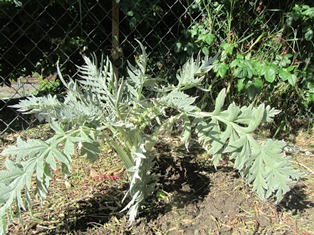
I managed not to kill the artichoke I planted last year and, thus encouraged, I would like to grow some other varieties
The artichoke (cynara cardynculus) listing in the catalog also intrigues me. The plant won’t produce chokes during its first year, but I don’t mind. Having an abundance of chokes for farmette meals makes me want to send for the seed right now. Don’t even get me started on all the herbs I want to order and plant! I might have to turn the farmette into a farm.
The Bountiful Gardens 2014 catalog is one of the best. Not only are the listings intriguing to read, the full-color pictures are nothing short of seductive for a gardener. Offerings include heirloom, open-pollinated, untreated seeds for sustainable growing of vegetables, grains, oil and forage crops, wild trees and shrubs, berries, herbs, and flower. The catalog even offers mushroom spawn. There are also books and media products available on gardening topics, composting, permaculture, self-sufficiency, garden pests, tools, seed saving, and much more.
If you are interested in getting your own copy of the 2014 catalog, write to Bountiful Gardens, 18001 Shafer Ranch Road, Willits, CA 95490; phone 707-459-6410. Or email: bountiful@sonic.net. See, http://www.bountifulgardens.org
Saving and Sharing Seeds
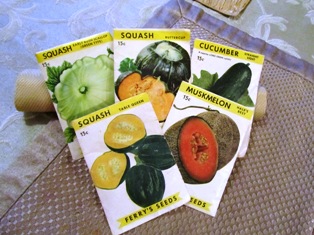
Packets of Ferry’s Seeds imprinted on the reverse with the words, “Packed for season,” and stamped 1958
Saving and sharing seed dates back to thousands of years before our forefathers brought their favorite heirloom seeds from their countries of origin to plant in their American gardens and fields. My grandmother, a frugal Scots-Irish farm woman, taught me by example how to save seed. I was six when I went to live with her in Boone County, Missouri. Our daily chores began before dawn.
She would strain the warm milk my grandfather brought from the barn after he had milked the cows. I was dispatched to the chicken house to collect eggs, sometimes from underneath hens still sitting on them. She would begin cooking the first of three hearty meals for the day.
With the breakfast dishes done, my grandmother and I would tend the vegetable gardens. We would hoe and weed by hand until the sun got high or until Grandma had decided which vegetables she wanted to include in the noonday meal. If her choice included tomatoes or beans, for example, they were gathered in baskets along with produce from her favorite plants from which she would remove and preserve the seeds.
She dried and stored the seed in paper envelopes or bags or glass jars. These she kept for planting in future gardens. The saving and sharing of seed among farmers and gardeners of my grandmother’s era and her ancestors was a traditional practice. Today, the practice continues with organic and home gardeners who share the belief that seed biodiversity must be ensured in keeping with natural evolutionary processes.
Today, commercial seed companies and corporations commonly file patents on seeds they have hybridized or cloned, making it illegal for farmers and gardeners to sell or otherwise distribute the seed. The hybridization produces a particular plant (that may have resistance to certain diseases or pests or display an unusual color, for example) in its first year, but second-generations of such hybrids may not come true. More alarming is the suggestion that reliance on commercial hybridized seed means the loss of thousands of varieties of open-pollinated plants such as those my grandmother grew.
Open-pollinated plants remain true to type and yield when planted from seed collected from the parent plant during the previous year. Some backyard gardeners, farmers, and plant growers today eschew using seed that has been genetically modified. They favor organic heirloom seed and are fueling an enthusiastic grass-roots effort to preserve the practice of saving and sharing seeds.
 Facebook
Facebook Goodreads
Goodreads LinkedIn
LinkedIn Meera Lester
Meera Lester Twitter
Twitter




